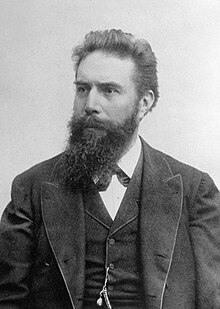Abundant in hospitals, dentist’s offices, and even research laboratories, x-ray machines are a common tool in our modern society. They have many uses, from determining where bones are broken, to visualizing the molecular structures of unknown compounds, to providing radiation therapy for cancer patients. Yet until 1895, x-rays—let alone the modern day machines—were unknown. Only due to a German physicist, Wilhelm Rontgen, do we have these useful tools.

On November 8th, 1895, Rontgen was experimenting with cathode ray tubes in his lab. These apparatuses are glass vacuum tubes equipped with an electron gun and a fluorescent screen to visualize the images. Rontgen typically ran electricity through the tube, causing it to glow. Yet on this day, he had wrapped the tube with black cardboard, expecting it to block all light. Unexpectedly, a chemical sitting a few feet away began to glow when he turned the tube on, even though the black cardboard should have prevented any light from escaping.

What had occurred was that the cathode ray did not just emit light—it sent out other, invisible rays which could pass through paper, glass, and wood. The chemical in the glass had reacted to these rays that the tube emitted, causing a light producing reaction. When Rontgen realized what had occurred, he entitled the particles x-rays—x for unknown. Thus, x-rays had been discovered accidentally.

After his ground-breaking discovery, Rontgen took an x-ray picture of his wife’s hand, showing her wedding ring and bones. Apparently, she was so terrified that upon seeing the image she proclaimed “I have seen my own death!” Despite Mrs. Rontgen’s fear, this photograph roused public interest, and led to more research on x-rays and their uses. Without this accidental discovery, we would lack the many instruments we have today that take advantage of the properties of x-rays.
I love how his first reaction to discovering some unknown form of radiation was to xray his wife’s hand. He could’ve melted it for all he knew.
Its still makes me wonder how these people find these things. I hope he did not have any side effects because then he would also be the first one to find radiation poisoning too.
It amazes me that I have never heard of this person before. It seems like such an important invention that is extremely common in the world today. It is weird how his wife was so freaked out by the picture, but was willing to place her hand in the beam of this unknown “x-ray.” I wonder why he did not test it on his own hand before he did it to his wife’s hand. Maybe, he actually did.